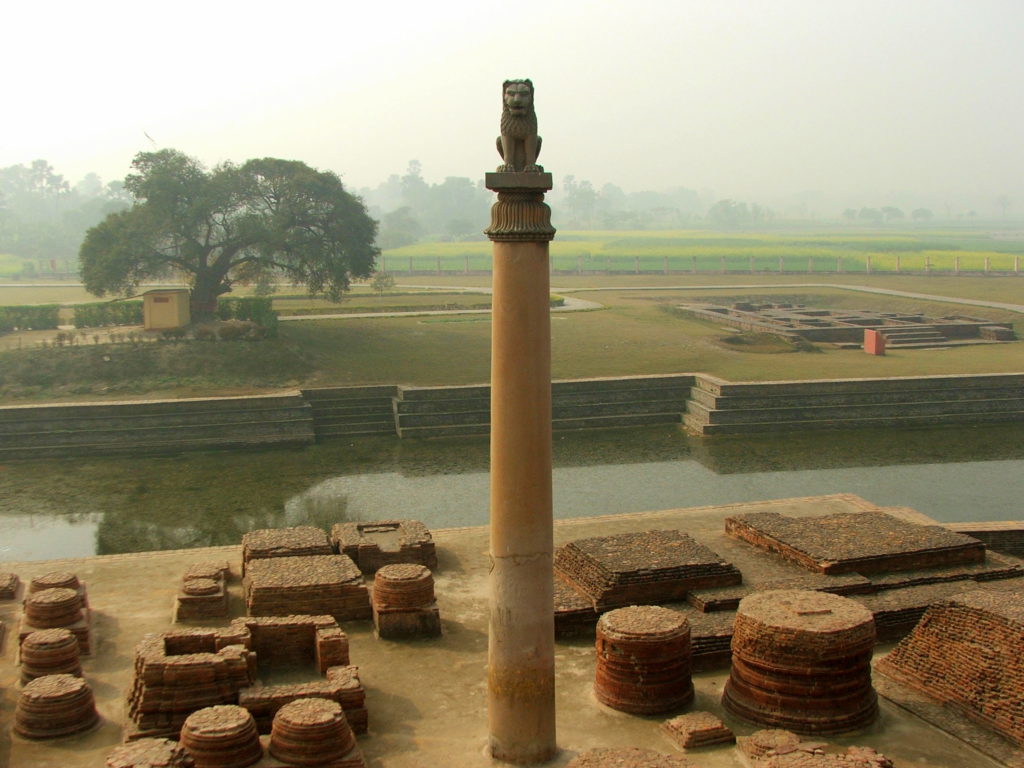One of the most important figures in Buddhist history was not a monk or sage, but an emperor. The Emperor Ashoka Maurya (304–232 BCE) is credited with making Buddhism a major religion throughout Asia.
Ashoka ruled a vast empire that spread from modern-day Afghanistan to the Bay of Bengal, including most of modern-day India. Through his patronage, Buddhism not only spread throughout this empire but into Sri Lanka as well. It is believed Ashoka’s Buddhist missionaries may have traveled as far as Egypt and Greece.
For more general biographies of Ashoka, see Ashoka the Great: India’s Mauryan Empire and Ashoka the Great: King of the Mauryan Empire of India. This article is going to look more specifically at Ashoka’s relationship with Buddhism.
The Edicts of Ashoka
The history of ancient times often is pieced together from questionable evidence. There are some things we know for certain about Ashoka, however, because of the edicts he left on pillars and rocks throughout his empire.
Historians believe these edicts are Ashoka’s own words.
In one “rock edict,” for example, Ashoka expressed regret for the deaths caused by his military conquests, in particular the slaughter of the people of Kalinga, which was in the same area as the state of Odisha, India. After the Kalinga War (ca. 265 BCE) Ashoka repented of violence and became a lay Buddhist.
From the edicts, it is clear that Ashoka’s rule was guided by the dharma. Buddhism became Ashoka’s state religion. People were not required to convert to Buddhism, however. Indeed, one of Ashoka’s most famous edicts called for tolerance of all religions in his realm. He desired “that all religions should reside everywhere, for all of them desire self-control and purity of heart.”
In his edicts Ashoka did not attempt to teach Buddhist doctrines. Instead, he promoted harmony, peace, justice and compassion, based on Buddhist principles. He instructed officials to help the poor and sick, and he called for restraint in the killing and harming of living beings, both human and non-human. He promoted the virtues of kindness, generosity, equanimity and truthfulness.
The pillars and rocks bearing the edicts have been found scattered throughout India, Nepal, Pakistan and Afghanistan. One particularly significant pillar was erected at Lumbini, the site of the historical Buddha’s birth. This site was lost for a thousand years until a German archaeologist found the Ashoka pillar in 1895.
Ashoka and the Monastic Sangha
Another source of information on the life of Ashoka are Buddhist chronicles kept in Sri Lanka, called the Mahavamsa and Dipavamsa. With these texts it is less certain than with the edicts where history ends and legend begins, however. The chronicles tell us that Ashoka sent his son Mahinda and his daughter Sanghamitta — a monk and a nun — to the court of King Tissa of Ceylon. Soon the King and his court were converted, and Buddhism has been practiced in Ceylon — today’s Sri Lanka — for 23 centuries.
Read More: Buddhism in Sri Lanka
More stories about Ashoka were recorded a text called the Asokavadana, which is believed to have been written by monks living in what is now the northern Indian state of Uttar Pradesh. These accounts probably are more legend than fact, however. In later centuries, Chinese pilgrims to India recorded stories they were told about Ashoka, but by then Ashoka’s life was remembered in myth.
However, it is apparent that Ashoka’s influence had a major impact on Buddhism. Before Ashoka, the Buddha’s teachings could be found only in a portion of present-day India, primarily in the Upper Ganges Valley. After Ashoka, Buddhism was known far beyond India.
Buddhist chronicles say that Ashoka personally convened the Third Buddhist Council in about 250 BCE at Pataliputra, an ancient city in what is now north central India. His purpose was twofold. One, he was responding to reports of heretical views and dissensions among the monks at Pataliputra. Ashoka is said to have interviewed each monk personally and dismissed monks who held beliefs contrary to the Buddha’s teaching — in particular, belief in an eternal, unchanging self.
Second, Ashoka appointed knowledgeable monks to go forth as emissaries to teach the dharma. This part of the story is confirmed by the edicts. These monks were assigned nine destinations, including Gandhara, Kashmir, Greece, Sri Lanka, Burma (Myanmar), Egypt, and Thailand.
Not all missions were successful. Buddhism did not take root in Thailand or Burma for a few more centuries after the Third Council. However, the missions to Greece and Egypt may have had some interesting effects. Scholars have long noted some blending of Hellenic and Buddhist thought that began about that time. There is also some archaeological evidence of Buddhists living in Alexandria.
The Mauryan Empire did not survive long after Ashoka’s death. The pillars and rocks bearing Ashoka’s edicts remained, but the Indo-Aryan language in which they were written faded from public memory. Outside of Buddhist chronicles Ashoka was forgotten, until British scholars translated the edicts in the 19th century. Thanks to this work, Ashoka is remembered today as a great and humane monarch.
